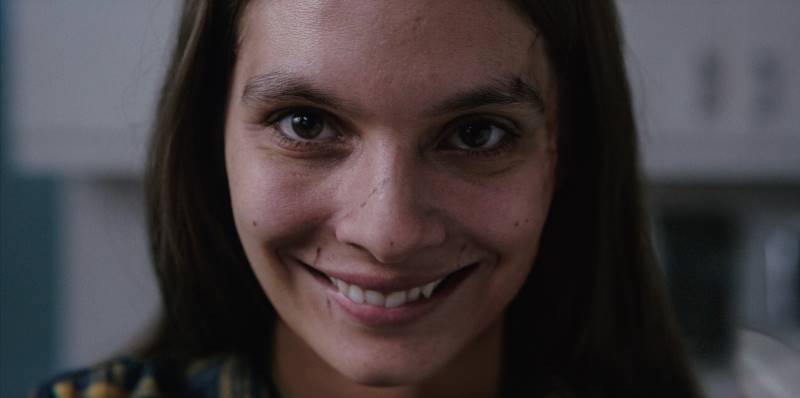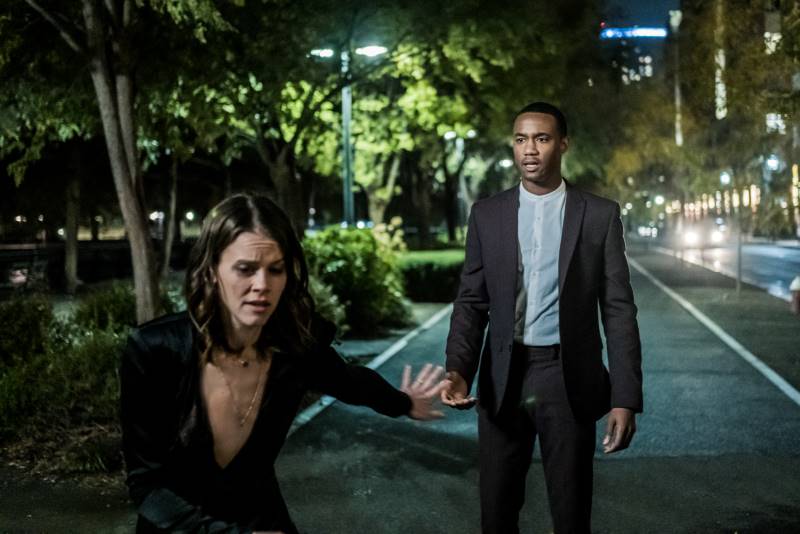You’ve knocked over our country. That’s for sure. Everybody I know who has seen Smile has just been like… wow!
I love that.
You worked with a couple of Australians on the film, managing to make Caitlin Stasey one of the scariest faces in Australia and also the incredibly talented cinematographer Charlie Sarroff, who worked on Natalie Erika James’ Relic.
Yes. Actually, our colourist on the film, Dave Cole, is also from Australia.

Are you surprised at how well the film has done?
I mean, gosh, yes. This was my first film, and I just didn’t know what to expect. I was just so grateful for the opportunity that I was given to even make the film. You have no idea how audiences are going to react to it or engage with it and seeing the way that it seems that audiences have embraced the film and connected to it, it’s been the most satisfying part of the experience to me.
It was originally slated for streaming, but I understand that test audiences were like, “No, we want to see this in the cinema.”
Yeah, which was a wild experience. Again, I couldn’t have been happier for the opportunity to just make something and for Paramount to have gotten behind it to put it on streaming was incredible, but when that decision got made to change it over to a wide international theatrical release, it is one of those dream come true moments. The big screen, the big sound, the communal experience is why I love movies, and I’m grateful that that’s the way that so many people got to see the film.
I think that you’ve crafted an important narrative about mental health. How important is it to you to get those kinds of themes across in your work?
That stuff’s really important to me. I always want to start with character. I think in horror films, it doesn’t matter how scary that thing that goes bump in the night is. If I’m not deeply invested in the main character, then it’s very hard for a horror film to scare me. I always start with the character’s journey and what is going on psychologically with the character and trying to ground the story with something that feels honest and real, so that when we go to these really extraordinary places, we’re willing to go there with the character.
It’s pretty much entirely shot from Rose’s [Sosie Bacon] point of view. I think that’s important to continue that investment in the character and the fact that she’s not entirely sure herself, whether she’s inherited her mother’s predilection for depression, whether she’s going through a breakdown, and that there are only two people who give her external validation that she isn’t.
I wanted the experience for the audience of watching the movie to parallel what Rose is going through and that the movie is doing to the audience what the psychological and supernatural elements are doing to Rose, so that it all becomes one and the same, and that you’re being gaslit and traumatised along with Rose the whole way.
She’s being traumatised by the people closest to her as well, so she becomes increasingly isolated and the last thing you need to be in a horror film is isolated…
Totally, and hopefully get all of those motifs to start speaking to one another.
You relied a lot on practical effects over CGI, which is great to see. Can you tell me a bit about what your choices were with that?
I grew up on practical effects. I’ve always loved them. It was one of the reasons I first became so interested in horror as a genre. I think that there is something really special that happens when you start with a practical effect. When there’s something for the performers to interact with, it’s just different in their performance. But I think also for an audience, unless you’ve got big Marvel budgets, I think we can sniff out a bad CGI effect. When you present something that at least the foundation of it is practical, then maybe there’s a few gaps being bridged with really well implemented visual effects that build upon the practical, you can create this scenario where the audience isn’t quite sure what they’re looking at and how it’s being achieved… That can be so, so immersive, and I love that about it.
It absolutely was immersive and scary as hell! You’ve managed to tap into a lot of primal fears that people have; the notion of the universal smile as something that is welcoming turning into something quite horrific…
I think it felt like an inherent contradiction. Smile certainly isn’t the first film in the history of horror cinema to utilise a smile in a creepy way, but I really loved the idea of how going beyond that, the way that we wear smiles as masks, I think that sometimes, if something is awkward or uncomfortable, we might put on a smile through it. Or even going deeper, I think if a lot of the guilt and trauma and depression and things that lots of us are walking around with every day, that expression to grin and bear it, and that we wear a smile as a mask to not let the outside world in on what we’re feeling. That metaphor of a smile as a mask felt really potent to me, and then making that literal with the evil in the film; that it’s actually wearing a smile as a mask, was just really fascinating to me.

It’s also echoed when Rose goes to her nephew’s party, and you can see that she’s struggling, but she has this one kind of smile on her face trying to bear up. That’s the smile of a depressed and traumatised person…
It felt like audiences could really relate to that scene and the feeling of being somewhere that is so counter to what you’re feeling inside but trying to just put on a smile and be there for it and just get through it. Of course, that birthday party in the movie goes far worse, I think, than what most people end up experiencing. That scene, that’s definitely a favourite of mine and the way it balances all the different tones.

Sosie Bacon as Rose is fantastic. How pleased were you to get her for the film?
I feel so grateful that she was my partner through this process. She’s an incredible actress. What she had to do, the degree of difficulty on this film was so high. She’s in almost every single scene, and she’s operating at these extreme levels of anxiety and discomfort and melodrama, while also really drawing an audience in and grounding the character and getting them to empathise with her. It’s no easy task, especially when you’re on a very tight schedule and you’re shooting everything out of order. She was a wonderful partner through the whole process.

You also have Jessie T. Usher (The Boys), who’s certainly a star on the rise.
Yeah, Jessie’s the best, and I think he’s such a charismatic, charming guy. I think that sort of oozes out of him, so that when you put him into a scenario where suddenly you’re like, “Oh my God, this character is driving me crazy,” there’s a really fun contradiction inside of that. He’s a total delight to work with.
The box office receipts are just amazing compared to the cost of the film. What are you going to be working on next?
I want to continue to be able to tell really bespoke genre stories that have a real character story at their center that are exploring what it is to be a human being but through being in extraordinary circumstances.
SMILE – BUY OR RENT NOW ON DIGITAL